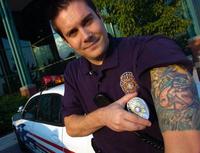-
Union Pacific settles drug fines, invests $50M in border security
Railroad giant Union Pacific Corp. agreed last week to invest $50 million to help protect the U.S.-Mexico border and to improve supply chain security; the announcement comes as the settlement of an ongoing dispute between the railroad company and U.S. border officials over nearly $500 million in fines
-
-
Detroit police to stop responding to unverified burglar alarms
As of Monday, 22 August, the Detroit police department will no longer respond to burglar alarms unless security companies can verify the need for an officer; the policy is aimed at reducing the number of false alarms and allowing officers more time to focus on critical duties; more than 98 percent of all burglar alarms are false alarms; critics of the new policy fear that it will exacerbate safety conditions in a city already plagued by crime and slow police response times
-
-
Combating tech-fueled flash mobs a new problem for police
With the help of cell phones and social networking sites, spontaneous swarms of youths have rushed into convenience stores or assaulted bystanders in a rash of “flash mobs” across the United States; law enforcement officials are struggling to find a way to effectively combat this new phenomenon which does not impede on privacy rights
-
-
New FBI app helps parents and police find missing children
The FBI has released its first mobile application aimed at helping parents locate their children when they go missing the Child ID app allows parents to electronically store photos and other vital information so that they will be able to provide law enforcement with critical details in a timely fashion if their child goes missing
-
-
"Cop shops" in Texas help fight apartment crime
Residents in Texas apartment complexes have begun dedicating entire units to police officers so they have a place to rest, take a break, and fill out reports; the cop shops help minimize crime by keeping officers in parts of town where their presence is needed
-
-
Columbine lessons helped thwart Tampa school tragedy

Police, having learnt the lessons of the 1999 Columbine High School massacre in Colorado, was in a better position to prevent violence in Tampa, Florida, last week; many school districts have threat assessment teams to try to connect the dots if there is a troubled, and potentially violent, student in their mix
-
-
Researchers developing graffiti analysis app
Law enforcement officials could soon have an app for their mobile phones that allows them to snap a picture of gang graffiti and have its meaning translated; gangs often use graffiti as a way of communicating messages like challenges or warnings to rival gangs and understanding its meaning could help fight crime
-
-
Micro Unmanned Ground Vehicle helps soldiers, first responders

Weighing just over ten pounds, Dragon Runner 10 (DR10) is small enough to carry in an assault pack and rugged enough to throw into buildings and hostile environments; the DR10 has multiple sensor and payload options, and thus is suitable for reconnaissance and surveillance missions to support small military units, patrols, and first responder teams
-
-
Phoenix police banned from sporting tattoos

In an effort to present a more professional image, an increasing number of police departments across the United States are requiring officers to cover up their tattoos; the Phoenix police department recently began requiring its officers to cover its tattoos, a move that has generated criticism due to the intense Arizona heat
-
-
Face-mapping app for smartphone searching
A new app, when combined with a centralized server, combs people’s cell phones looking to find photos that have a face in them that match what someone is looking for; the app could be used to look for an abducted child, or a criminal hiding in crowds
-
-
Anonymous retaliates against BART
The hacking collective Anonymous released personal data on Sunday belonging to more than 2,000 public transport customers in the San Francisco area in retaliation for the Bay Area Rapid Transit (BART) system’s shutdown of mobile phone service on Thursday night
-
-
Portable, super-high-resolution 3-D imaging
A simple new imaging system could help manufacturers inspect their products, forensics experts identify weapons, and doctors identify cancers.
-
-
U.K. police procurement hub goes live
The U.K. launches a new, Amazon-style online procurement process which enables police forces to buy specified goods and services online; all forty-three U.K. police forces are expected to be using the hub by June 2012
-
-
Four days of rioting strains U.K. legal system

The ongoing unrest in the United Kingdom has begun to strain the country’s criminal justice and law enforcement system; with police arresting hundreds of people over the last few days, local judges have had trouble keeping up with the case load and facilities have quickly become overcrowded
-
-
Anonymous hacker collective hits rural law enforcement

In its latest exploit, global hacker collective Anonymous claimed to release ten GB of stolen data from more than seventy rural sheriff’s departments across the United States, leaking sensitive information that could compromise the agencies’ investigations
-
More headlines
The long view
How Male Grievance Fuels Radicalization and Extremist Violence
Social extremism is evolving in reach and form. While traditional racial supremacy ideologies remain, contemporary movements are now often fueled by something more personal and emotionally resonant: male grievance.
